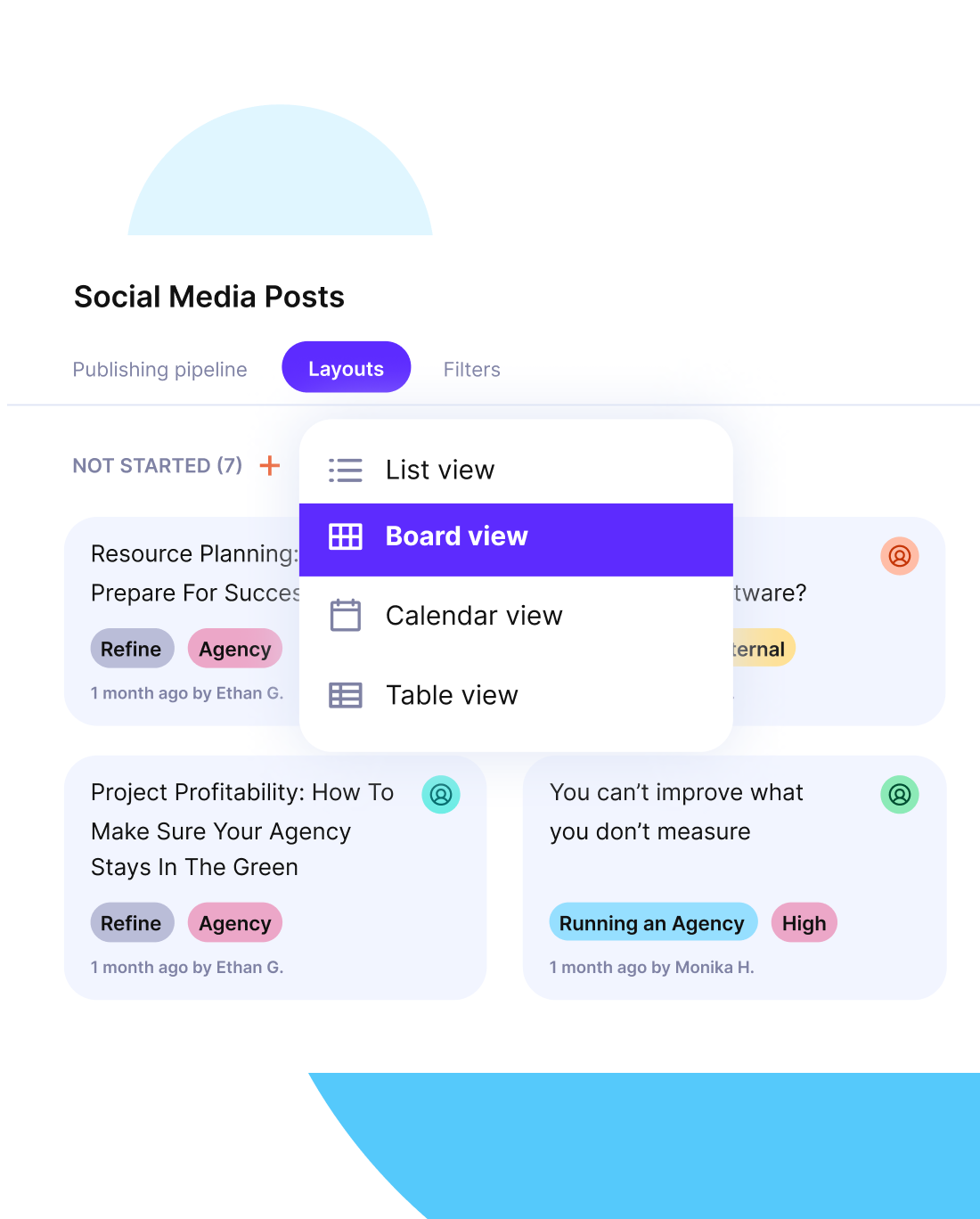How To Improve Client Communication: Best Practices + Guide
If your client relationships are not doing great because of slow responses, unclear updates, or missed expectations, you’re not alone.
Stick with this guide to learn the best practices of client communication, how to build stronger relationships, avoid misunderstandings, and what tools to use to communicate better.
Key Takeaways
- Good communication with clients is an integral part of project management because it builds trust, prevents misunderstandings, and boosts retention.
- Poor communication can cost you business relationships, lost deals, churn, and delays.
- Proactive, structured communication is more effective than reactive messaging.
- Modern communication tools like project management software with client portals, chat apps, and automation can save time, improve clarity and enhance client engagement.
What Is Client Communication?
Client communication is the ongoing exchange of information between your team and your clients throughout a working relationship. This client correspondence includes emails, text messaging, meetings, reports, feedback sessions, and even silent gaps where clients are waiting to hear from you.
Customer communication includes everything from onboarding and project updates to billing and post-project check-ins.
- Done well, it keeps everyone aligned and moving forward.
- Done poorly, it leads to confusion, frustration, and churn.
Why Does Client Communication Matter?
Client communication matters because it directly impacts how well projects run, how satisfied clients are, and whether they choose to work with you again.
Missed messages or vague updates create friction, slow down progress, and make it harder for clients to see you as the one leading the project. Clear, consistent communication reinforces trust and keeps the relationship on solid ground.
When clients feel like they’re chasing what should be regular updates or guessing what’s next, it affects how they perceive your reliability. Communication isn’t just about exchanging information – it’s how clients judge whether you’re in control and on top of things.
It Impacts Perception
When clients have to follow up for updates or find out about changes on their own, it sends the wrong message. It makes it seem like you’re not in control of the project (even if you’re delivering as promised).
Good communication reinforces the sense that you’re on top of things and helps clients stay confident in your work.
It Shapes Your Brand
How you communicate affects how clients perceive your professionalism. If updates feel disorganized or reactive, it reflects poorly (even if the work is solid). Clear, consistent communication helps reinforce the idea that your team is organized, reliable, and easy to work with.
It Sets Expectations
Setting clent expectations early (like in the onboarding process) helps avoid last-minute surprises around timelines, scope, or budgets. When you keep things clear from the start, it’s easier for clients to stay aligned and for your team to stay focused.
Common Consequences of Poor Communication
When communication is scattered, unclear, or vague, clients often feel like they’re managing the process themselves. If that feeling sticks around, you can say goodbye to the client and hello to churn, lost revenue, and additional rework.
Here’s what that looks like in practice:
- Deals fall through when updates are missed or key questions go unanswered. It’s normal that teams lose sales mid-funnel due to poor communication and follow-up. Make sure that doesn’t happen to your sales reps.
- Clients churn when they feel out of the loop or need to chase down information. This is actually a top risk for many agencies, especially when interactions with clients happen across multiple channels (Slack, text messaging, email, and spreadsheets).
- Rework happens because client feedback isn’t captured clearly or expectations weren’t aligned early. More additional work slows delivery and stretches timelines.
- Internal teams lose focus when they’re unsure what was agreed with the client or where to find the latest update. This leads to unnecessary follow-ups, duplicated effort, project delays, workflow breakdowns, and friction.
How to Improve Client Communication – Best Practices
You can improve client communication by simplifying tools, clarifying roles, and giving everyone a shared view of what’s happening.
Most problems start when messages, updates, and files are scattered across platforms. This causes missed follow-ups, duplicated effort, or rework. Strong client management strategies focus on creating structure and consistency, so teams can avoid these pitfalls.
Productive solves these problems by centralizing all client interactions into one shared workspace, keeping everything organized and visible in one place.
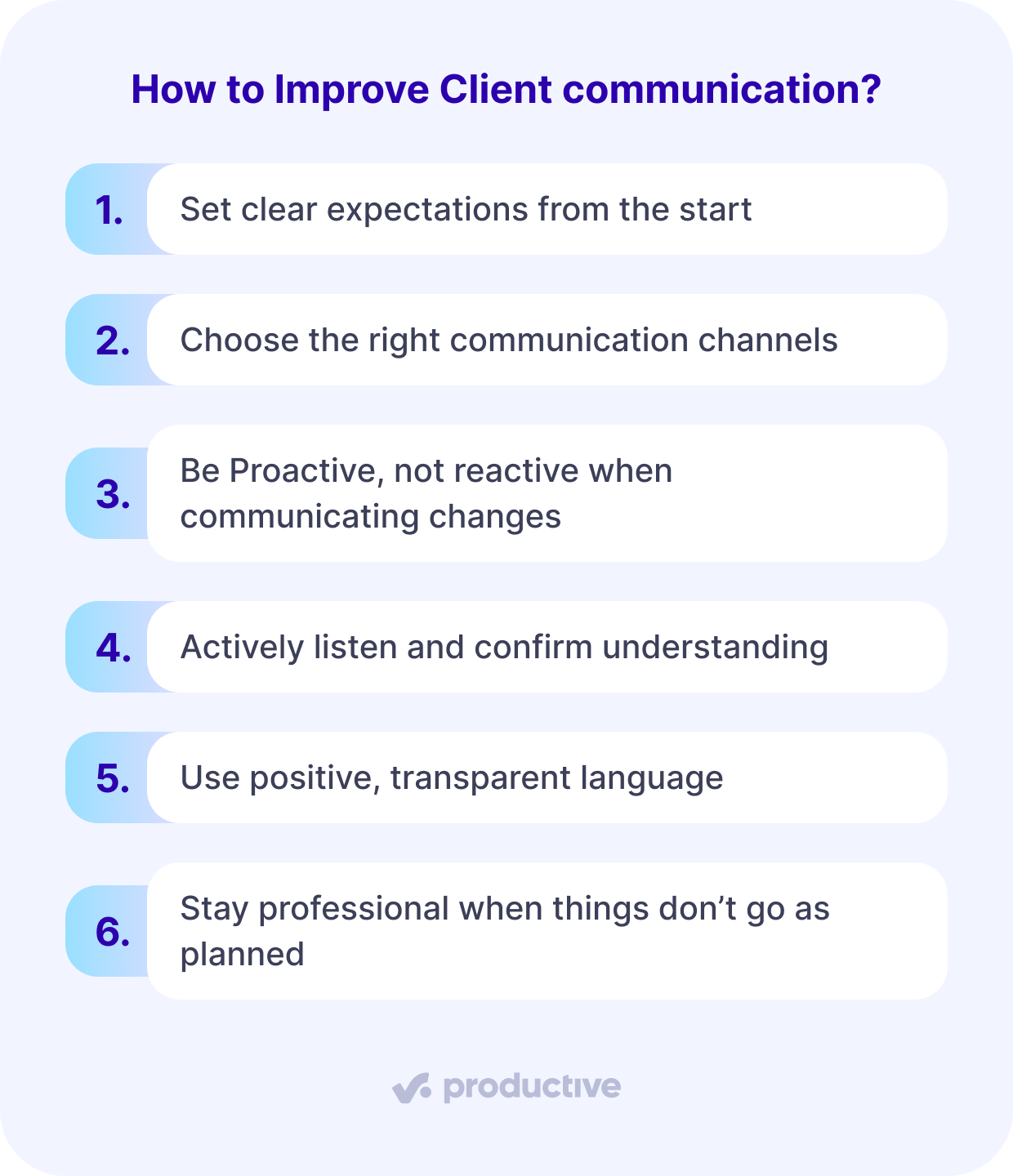
Below, we’ll show you the proven best practices for improving client communication.
Set clear expectations from day one
Unclear onboarding is a common friction point – clients don’t know where to go, who to talk to, or what’s expected. Some teams even create extra spreadsheets just to track and communicate project actions.
Instead, use a shared client communication plan:
- Assign roles and main points of contact.
- Define what will be shared and how (e.g., portal vs. email).
- Set a check-in rhythm early.
- Clarify what clients can access.
Productive’s client portal lets your project teams and customers work in one place. You can create and share welcome documentation and project details so onboarding starts smoothly and stays organized.
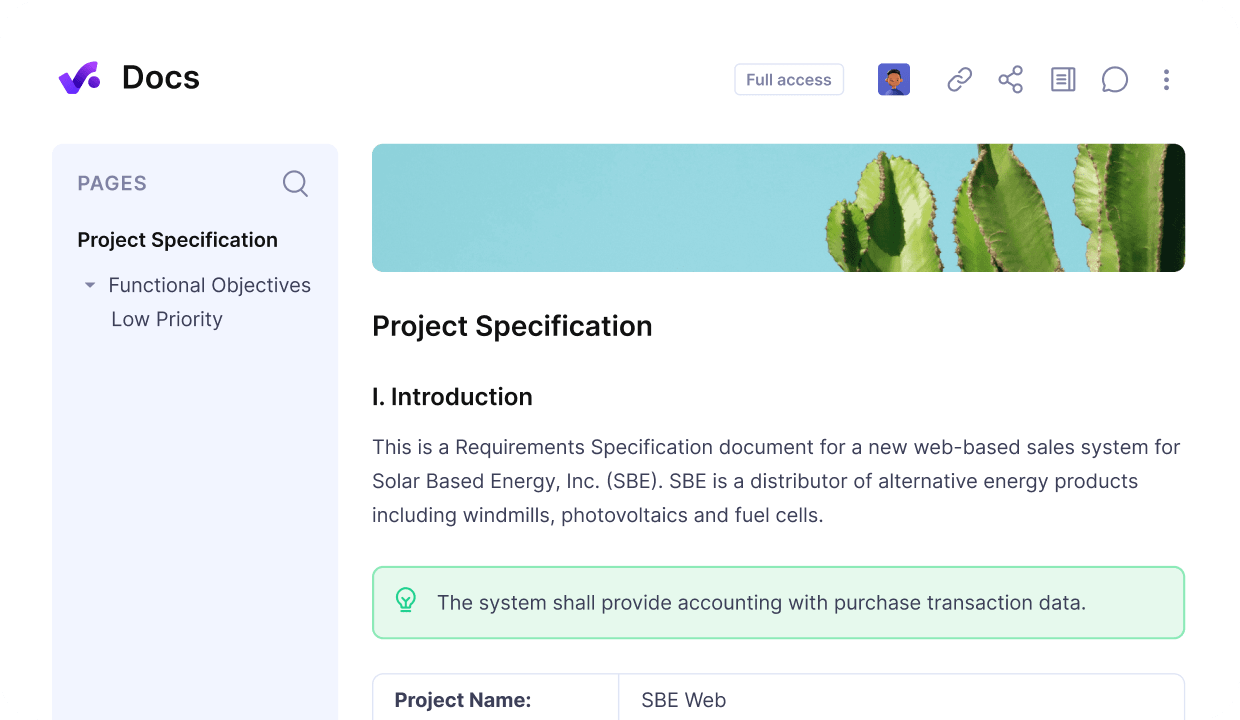
Communicate with your clients on project documentation.
Choose the right channels
Different messages need different formats, but many teams struggle because their business communication channels are overloaded or misused.
It’s not uncommon to see client feedback spread across Slack, action items buried in email threads, and status updates lost in spreadsheets. That big problem is super frequent for agencies juggling multiple projects for multiple customers.
Choosing the right format isn’t just about efficiency – it’s about setting a consistent rhythm that your clients can rely on.
Here’s a short overview of different channels, formats, and when to use them.
| Channel | Best Used For |
|---|---|
| Formal updates, documentation, and approvals | |
| Video Calls | Big-picture discussions, feedback loops, and brainstorming |
| Client Portals | Centralized access to timelines, deliverables, and status updates |
| Chat Apps (e.g. Slack, MS Teams) | Quick questions, file sharing, and informal touchpoints |
Keep in mind that more channels ≠ better communication, so don’t overwhelm. Aim to centralize your client-facing operations in a single place.
Manage all client communication with Productive
Be Proactive, not reactive in all your client communications
Manual client updates are one of the biggest time drains of billable work. They are especially frequent when status reports live in spreadsheets or PDFs that need exporting and updating every week.
Real-time project visibility is something that many teams struggle with.
In Productive, clients can view live project dashboards that show progress bars, timelines, and upcoming deliverables (without needing your team to send a thing). When updates are needed, automated reports can handle that, too.
Actively listen and confirm understanding
A big source of rework and misalignment is assuming you understood what the customer meant (when you didn’t). To avoid this, you should build in small habits (like active listening) that close the loop during every interaction.
- Paraphrase their input: After a client shares feedback, repeat it back in your own words. Example: “So what you’re looking for is a single-view dashboard that includes both timelines and resourcing – did I get that right?”
- Ask for clarification early: If a message feels vague, follow up immediately rather than guessing. It’s faster to clarify than to redo work.
- Recap after calls or email threads: A one-paragraph summary with clear next steps reduces the chance of misunderstanding. It also shows that you’re paying attention and owning the process.
Why it matters: Agencies often lose time fixing deliverables that were technically done (but not quite what the other person had in mind). Listening carefully and confirming the ask up front avoids that kind of costly back-and-forth.
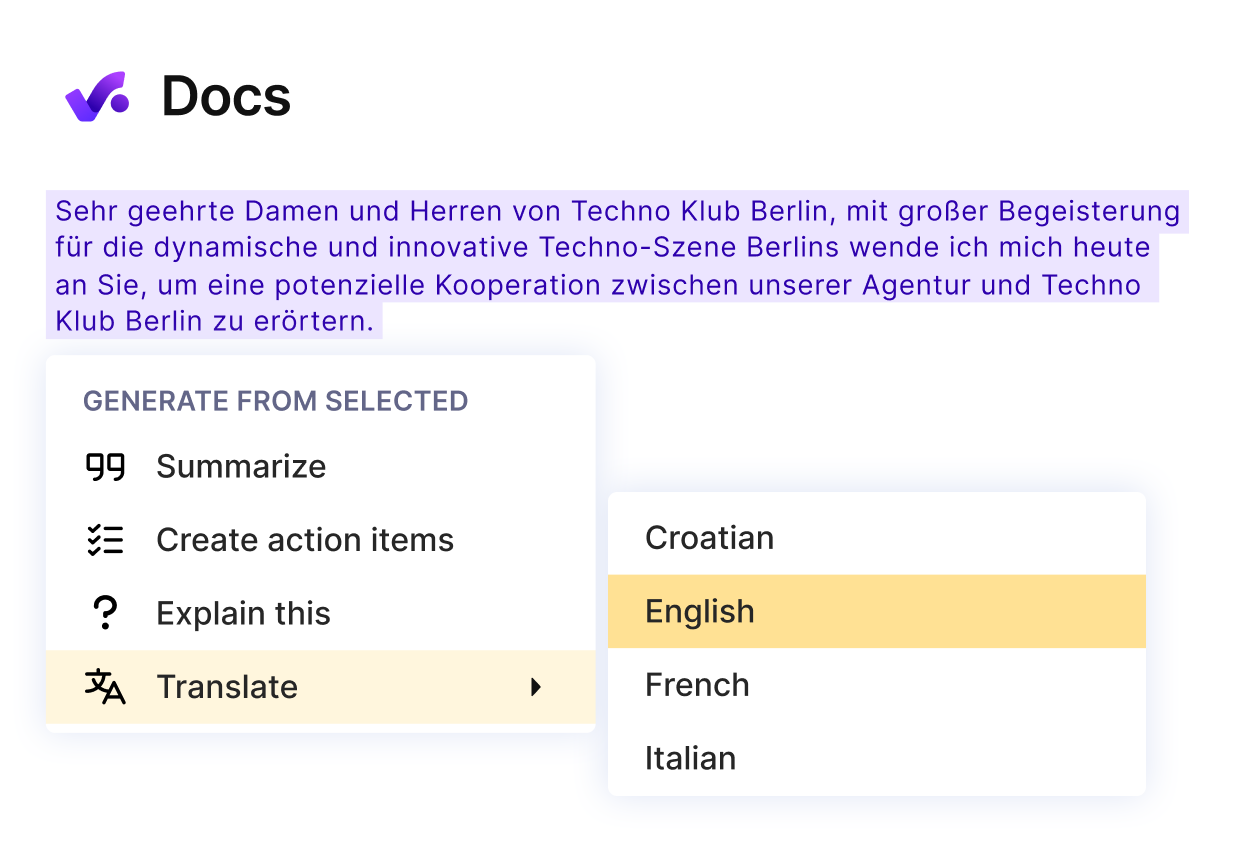
Use AI to summarize notes or create ACTION ITEMS.
Use positive, transparent language (even in nonverbal communication)
How you phrase updates affects how your customers perceive your team, especially when plans change. The goal isn’t to sugarcoat or sound overly nice, but to be clear, action-oriented and keep your clients informed.
Here are our top tips for improving your communication skills:
- Focus on what’s next: Instead of saying, “We’re behind,” say, “We’re adjusting the timeline and here’s how.” This shows ownership and direction.
- Give context, not excuses: Example: “The revision took longer because of added scope. We’ve now built in more buffer moving forward.” Clients appreciate transparency when it’s paired with a fix.
- Avoid vague or soft language: Words like “hopefully” or “might” create uncertainty. Swap them for concrete phrasing that reflects actual progress.
Why it matters: Unclear phrasing often causes unnecessary follow-up. Customers don’t just want status updates – they want clarity and confidence.
Productive is a huge help here because it gives your team one source of truth, so updates are accurate, consistent, and grounded in real-time project data.
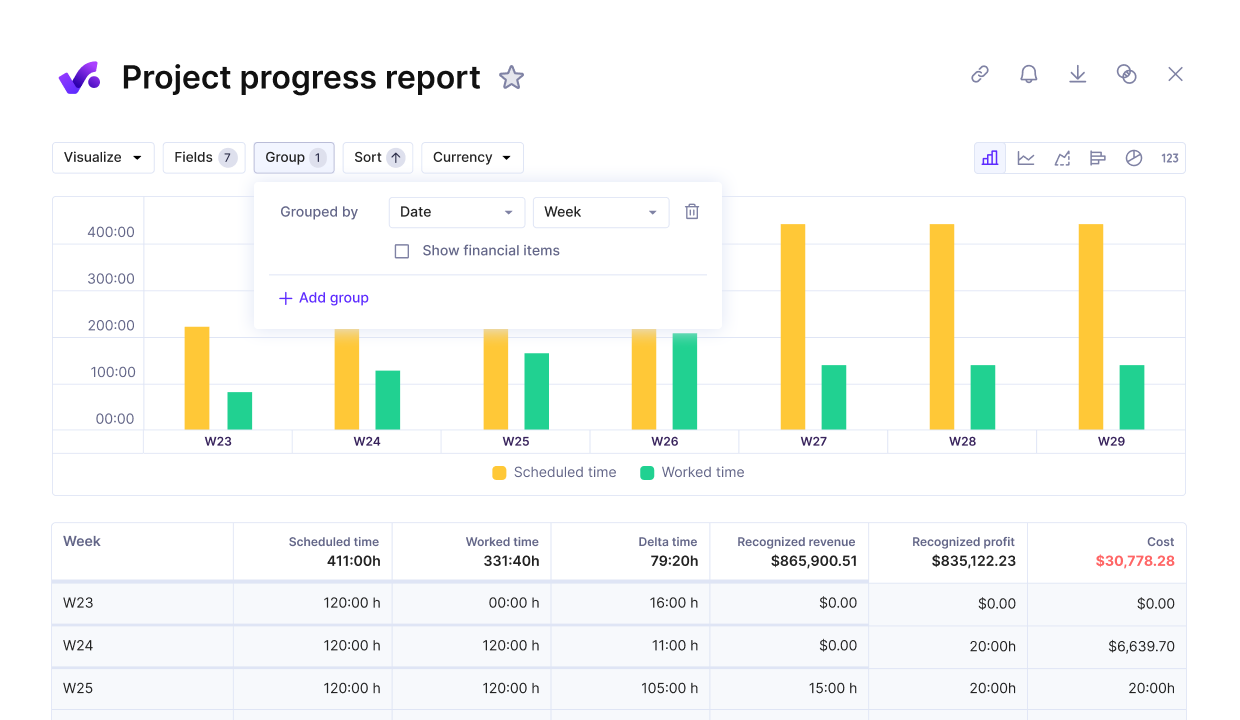
Get shareable reports on project progress.
Stay professional when things go sideways
When things don’t go according to plan (like missed feedback, late approvals, or scope changes), customers notice how your customer support responds.
Staying calm, clear, and organized shows that you’re still leading the project, even when timelines shift.
- Acknowledge the issue and show the path forward: For example, “We’re currently two days behind due to delayed feedback, but we’ve revised the timeline and added an internal buffer.”
- Use your system to create clarity: Keep status updates, notes, and change logs accessible to clients so they’re not left guessing.
- Stick to the process even under pressure: Use documented feedback cycles and approval workflows to guide the conversation back to structure.
Why it matters: Agencies often lose credibility not because of the issue itself, but because of how the response is handled. When clients don’t see a clear plan or next step, they lose confidence.
Productive gives you concrete forecasts, so that you can explain to the client how the changes will impact the outcome.
You can also use the Scenario Builder to figure out what to change to achieve the best possible outcome for your client, and make big decisions with more confidence.
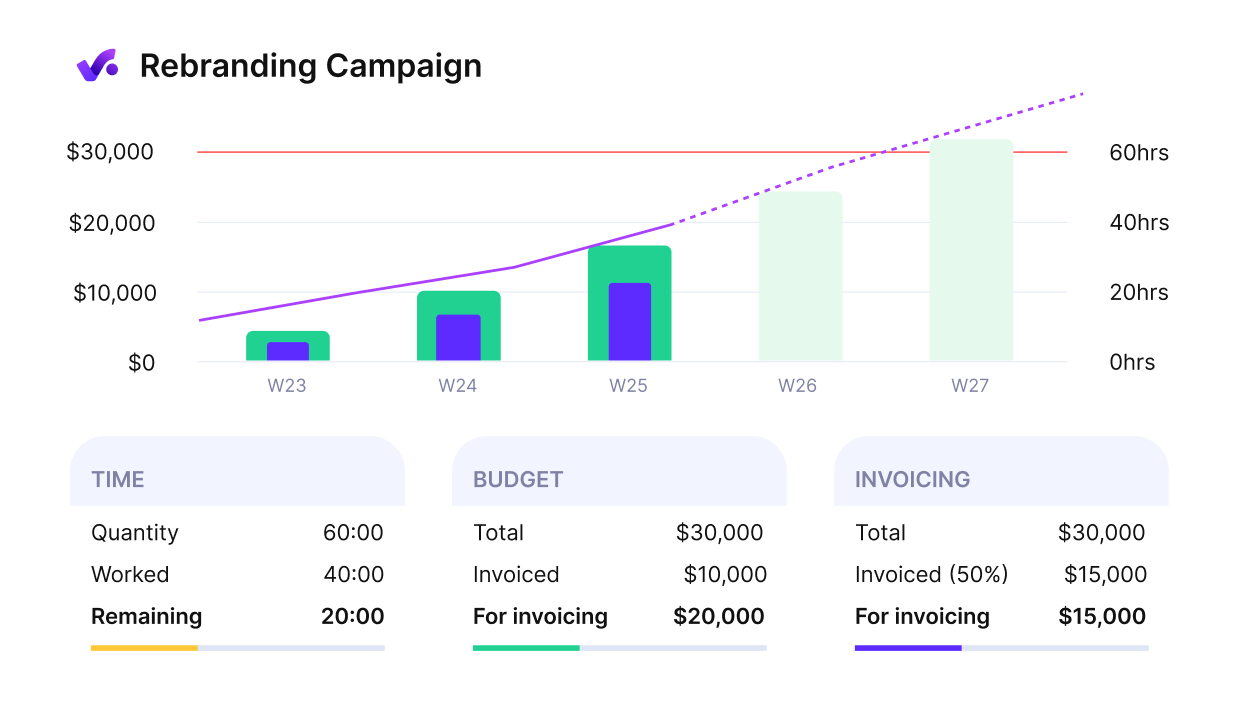
Get an early warning if of budget overruns.
What Tools To Use for Better Communication?
The best tools for better communication are messaging apps and project management software with centralized client portals. The idea is to keep messages, updates, documents, and timelines in one place (without forcing your team to jump between tabs or chase updates manually).
Below are the essential categories that support better, more consistent client interactions.
Use a centralized client portal for workplace communication
When clients don’t know where to find updates, documents, or project milestones, they send more emails (or worse, stop checking in altogether).
- What to use: A communication platform like Productive that includes a shared client portal.
- Why it helps: Centralized tools keep everything in one place (so clients always know where to look without sending update requests).
- How to use it well: Share onboarding docs, timelines, and deliverables (tasks) with assignees so they’re always accessible.
In case you need choosing advice, check out our list of the best project management software with client portal.
Stick to messaging for quick updates
Messaging tools are great for quick questions and file handoffs, but they’re a terrible place to manage scope or approvals.
- What to use: Slack, Microsoft Teams, or in-app chat built into your project management tool
- Why it helps: Speeds up communication, but only when used with boundaries
- How to use it well: Keep it lightweight. Don’t make critical decisions or document revisions in chat.
Connect client interactions to project management
One of the biggest pain points for many companies is teams giving clients outdated info because internal systems aren’t connected to external updates.
- What to use: Project management tools like Productive that combine communication with tasks, budgets, and resourcing. Everything is, of course, in real-time.
- Why it helps: Keeps everyone aligned on actual progress without duplicating status updates.
- How to use it well: Sync internal and client-facing views so everyone sees the same plan.
In case you need more food for thought, you might want to check out our guide on how to choose PM software.
Automate routine updates & support
Manually sending the same reminders and status notes wastes time and introduces human error. Teams often get frustrated over creating weekly check-ins or chasing clients for approvals.
Some use separate Excel trackers just to prepare client-facing updates, which isn’t a good thing.
- What to use: Automated reports, scheduled status notifications, and self-serve knowledge bases
- Why it helps: Saves time, reduces admin work, and helps clients stay informed without nudging
- How to use it well: In Productive, you can schedule updates using the “When” step in Automations. For example, you can automatically trigger status emails to clients every Friday at 4 pm when a project reaches a specific phase or label. You can also combine this with actions like sending a comment or updating a field. Features like that ensure that the right message goes out without manual effort.
What Are Proven Psychological Strategies for Effective Communication?
Proven psychological strategies for effective communication with clients are: the NURS technique (reset tone in tense situations), the norm of reciprocity (builds mutual trust), and adapting your communication style using the chameleon effect (improves rapport, consistent, confident communication).
Stick with the article because below we’ll show you how each strategy works along with practical examples.
Use the NURS technique to defuse tense moments
When a client is stressed or frustrated, using empathy (display emotional intelligence) and structure can quickly reset the tone.
- Name the emotion: “Sounds like this delay has been frustrating.”
- Show understanding: “That makes sense, we’ve seen how this can throw off internal plans.”
- Recap the concern and align: Repeat their ask to make sure you’re solving the right thing.
- Collaborate on next steps: Offer one or two options that show progress.
Why it helps: Clients who feel heard are far more likely to stay engaged, even if budgets or time entries shift.
This technique is especially useful when paired with Productive’s approval flows and comment history, so you have full context to respond clearly.
Apply the Norm of Reciprocity to build trust
Clients respond positively when they feel like you’re invested. Proactively sharing useful templates, insights, or updates (before being asked) makes customers more willing to reciprocate with timely feedback and decisions.
Productive makes this easy with reusable templates, timeline previews, and visibility settings that let you share progress proactively (without extra manual work).
Why it helps: Small up-front investments (like sharing a rough timeline or giving early visibility in Productive) often speed up approvals and reduce last-minute surprises.
Mirror to build rapport (Chameleon Effect)
Matching tone and communication style (not mimicking, just adapting) can improve how customers perceive your collaboration.
- If a client prefers bullet points, send bullet points.
- If they’re formal, don’t get overly casual.
- If a client shares screen recordings or Loom videos, match that format in your feedback.
Why it helps: Customers interpret fluency in their “language” as professionalism. This subtle alignment shows attention to detail and builds trust over time.
How to Know If Your Communication Is Working?
You can tell if your client communication is working by looking at how often customers follow up, how clearly they respond, and whether key milestones move forward without confusion. Communication works when it reduces the need for clarification, not when it creates more of it.
We talk more about communication in our detailed agency operations guide.
Track the signals that matter
- Response times: Are replies timely, or are customers waiting too long?
- Client sentiment: Use short surveys or NPS to measure how users feel over time.
- Project outcomes: Fewer delays, scope changes, or repeated questions often point to stronger communication.
- Feedback quality: Are users engaged in reviews, or are they hands-off and unclear?
There are a whole lot more metrics you should keep your eyes on. If you’d like a detailed overview read our guide on the most important project management metrics.
Use Productive to surface the gaps
Productive helps you measure and improve this process by centralizing updates, task comments, and big decisions in one place. With everything documented and time-stamped, it’s easier to identify lags, missed approvals, or updates that didn’t land.
Make feedback questions a part of the process
Instead of guessing how things are going, build feedback into your regular check-ins. Ask your customers how could you communicate smoother. Small tweaks (like adjusting when updates go out or how they’re formatted) often make a big difference.
Improvement starts with measurement, testing, and incremental changes (baby steps).
Closing Thoughts
Improving client communication means solving the friction that slows work down: unclear updates, missed feedback, scattered tools, or repeated follow-ups. Agencies particularly struggle with poor, one-sided interactions because they don’t have a structured plan to communicate with their clients that includes different scenarios.
Productive helps you fix that. It gives you one workspace where project updates, approvals, timelines, and tasks all stay connected. As a result, nothing gets lost, and customers stay confident in your delivery process.
Book a quick demo to see how Productive helps you simplify client communication and stay in control of your projects.
Improve Client Communication with Productive
Productive keeps all communication, files, finances, and real-time progress visible in one shared workspace.
